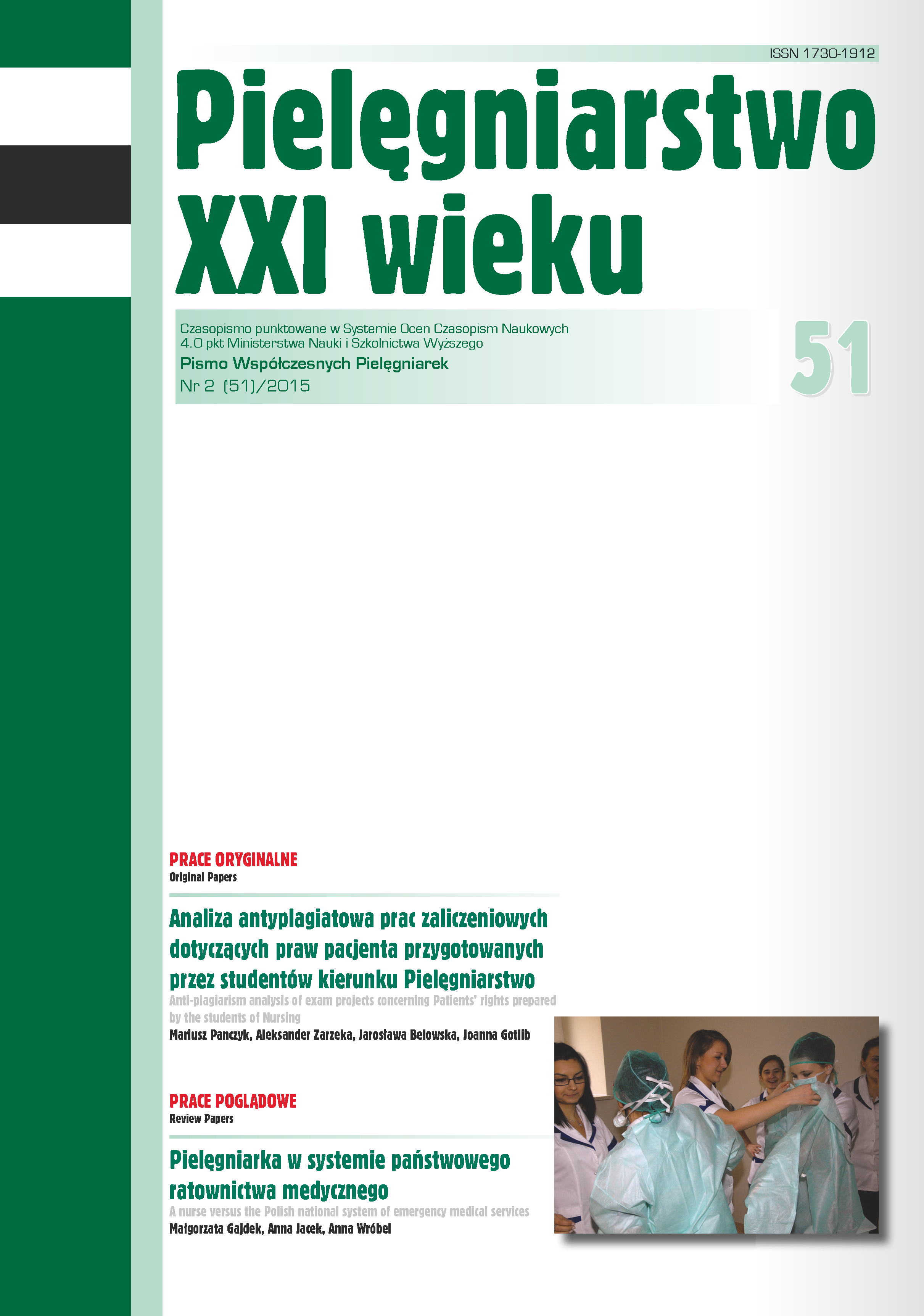Analysis of the level and type of support peri-menopausal women receive
DOI:
https://doi.org/10.12923/p21w-2015-2/13Keywords:
social support, perimenopausal period, socio-demographic factorsAbstract
ANALYSIS OF THE LEVEL AND TYPE OF SUPPORT PERI-MENOPAUSAL WOMEN RECEIVE
Introduction. Perimenopausal period is a time when numerous biological and psychological changes occur to women. This might be a particularly difficult time, since there are also numerous social changes happening. Every female undergoing these changes could expect support from others, which may be conditioned by various factors.
Aim. An analysis of both the level and type of social support, depending on the socio-demographic characteristics of women at perimenopausal age.
Material and methods. The study covered 268 women at perimenopausal age. The qualification criteria were as follows: age 45-55, lack of mental disorders, no diseases requiring hospitalization during the period of study. The study was conducted using the Social Support Scale by Kmiecik-Baran and a questionnaire designed by the authors of this work.
Results. The authors’ own study looking at the level and type of support that women receive showed that age, education level, and marital status did not affect the level of social support the women received. This pertains both to the overall and detailed evaluation, with the division into particular types of support received by respondents (informative, instrumental, evaluative, emotional.
Conclusions. The women looked at in the study received social support at an average level, irrespective of its type. There was no correlation between the age, education or marital status and the type of support they received.
References
1. Bielawska-Batorowicz E. Występowanie objawów uznawanych za typowe dla menopauzy u kobiet i mężczyzn w wieku 45-55 lat. Prz. Menopauzalny. 2005; 1: 53-60.
2. Humeniuk E, Bojar I, Owoc A, et al. Psychosocial conditioning of depressive disorders in post-menopausal women. Ann. Agric. Environ. Med. 2011; Vol 18; No 2: 441-445.
3. Kmiecik-Baran K. Skala wsparcia społecznego. Teoria i właściwości psychometryczne. Prz. Psychol. 1995, 38: 201-214.
4. Kmiecik-Baran K. Skala wsparcia społecznego (SWS). [w:] Kmiecik-Baran K. Narzędzia do rozpoznawania zagrożeń społecznych w szkole. Wydawnictwo „Przegląd Oświatowy”, Gdańsk; 2000: 48-61.
5. Sęk H. O wieloznacznych funkcjach wsparcia społecznego. [w:] Cierpiałkowska L., Sęk H. (red.) Psychologia kliniczna i psychologia zdrowia. Wybrane zagadnienia. Poznań: Wydawnictwo Fundacji Humaniora. 2001: 13-32.
6. Sęk H, Cieślak R. Wsparcie społeczne – sposoby definiowania, rodzaje i źródła wsparcia, wybrane koncepcje teoretyczne. [w:] Sęk H, Cieślak R. (red.) Wsparcie społeczne, stres i zdrowie. Warszawa: Wydawnictwo Naukowe PWN. 2006: 11-28.
7. Bresnahan MJ, Murray-Johnson L. The healing web. Health Care Women Int. 2002, 23: 398-407.
8. Knoll N, Schwarzer R. Prawdziwych przyjaciół...Wsparcie społeczne, stres, choroba i śmierć. [w:] Sęk H, Cieślak R. (red.) Wsparcie społeczne, stres i zdrowie. Warszawa: Wydawnictwo Naukowe PWN. 2006: 29-48.
9. Głębocka A, Szarzyńska M. Wsparcie społeczne a jakość życia ludzi starszych. Gerontol. Pol. 2005, 13 (4): 255-259.
10. Holt-Lunstad J, Birmingham W, Jones BQ. Is there something unique about marrige? The relative impact of marital status, relationship quality, and network social support on ambulatory blood pressure and mental health. Annals Behav. Med. 2008, 35: 239-244.
11. Zielińska-Więczkowska H, Betłakowski J. Pomiar i ocena wsparcia społecznego u pacjentów hospitalizowanych poddanych chemioterapii. Współczesna Onkologia 2010; vol 14; 3: 229-232.
12. Stringhini S, Berkman L, Dugravot A et al. Socioeconomic status, structural and functional measures of social support, and mortality.The British Whitehall II Cohort Study, 1985–2009. American Am J Epidemiol. 2012; 175 (12): 1275-1283.
13. Blom M, Georgiades A, László KA et al. Work and marital status in relation to depresive symptoms and social support among women with Coronary Artery Disease. J. Women’s Health 2007, 16, 9: 1305-1315.
14. Wrześniewski K, Włodarczyk D. Rola wsparcia społecznego w leczeniu i rehabilitacji osób po zawale. [w:] Sęk H, Cieślak R. (red.) Wsparcie społeczne, stres i zdrowie. Warszawa: Wydawnictwo Naukowe PWN. 2006: 170-189.
15. Greenglass E. Różnice wynikające z ról płciowych, wsparcie społeczne i radzenie sobie ze stresem. [w:] Sęk H, Cieślak R. (red.) Wsparcie społeczne, stres i zdrowie. Warszawa: Wydawnictwo Naukowe PWN. 2006: 138-151.
16. Gorman BK, Sivaganesan A. The role of social support and integration for understanding socioeconomic disparities in self-rated health and hypertension. Soc Sci Med. 2007; 65 (5): 958-975.
17. Zielińska-Więczkowska H, Pyrka K, Muszalik M, i wsp. Wsparcie w opiece pielęgniarskiej pacjentów w podeszłym wieku przed zabiegiem operacyjnym – na tle czynników socjo-demograficznych. Psychogeriatria Polska. 2012; 9 (2): 61-68.
Downloads
Published
Issue
Section
License
Copyright (c) 2024 Katarzyna Kanadys, Magdalena Lewicka, Magdalena Sulima, Henryk Wiktor (Autor)

This work is licensed under a Creative Commons Attribution 4.0 International License.




